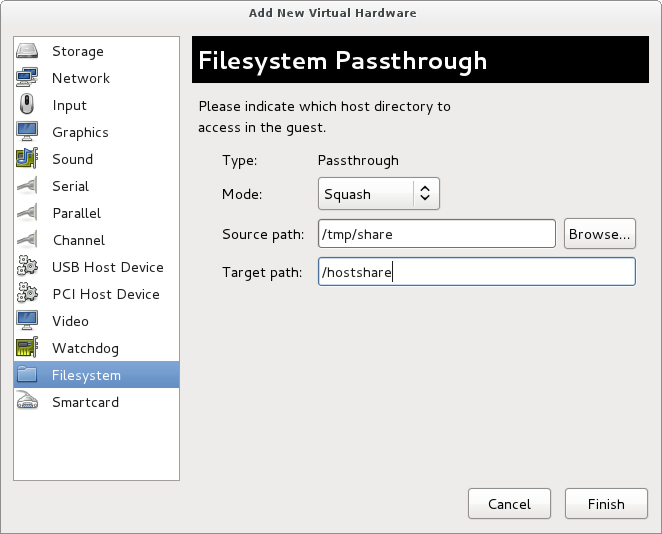9p virtio: Difference between revisions
mNo edit summary |
m (added categories) |
||
| Line 36: | Line 36: | ||
That's it...now we can read/write files in that directory from either the host or the guest. (Note: likely to hit some issues w/ privileges since Fedora libvirt runs guests unprivileged and with SELinux confinement...careful use of chown, chmod and chcon should get it working). | That's it...now we can read/write files in that directory from either the host or the guest. (Note: likely to hit some issues w/ privileges since Fedora libvirt runs guests unprivileged and with SELinux confinement...careful use of chown, chmod and chcon should get it working). | ||
[[Category:Docs]][[Category:HowTo]] | |||
Latest revision as of 08:39, 31 May 2015
Example Sharing Host files with the Guest
This example is based on qemu-kvm (0.15.0) as installed in Fedora 15. Will first show how to do this manually, and second how to do it using the virt-manager tool. This HOWTO is documenting 9p virtio as the transport for sharing files.
In both cases we'll share files in /tmp/share on the host. In the guest, they'll show up in /tmp/host_files.
Manually, using qemu-kvm command line
There are a nice set of details on the QEMU wiki describing this, so this section will be quite short. To share host files w/ the guest, we use 9p over virtio in conjunction w/ a filesystem device exporting the portion of the host filesystem that we'd like to share with the guest.
# /usr/bin/qemu-kvm -m 1024 -name f15 -drive file=/images/f15.img,if=virtio -fsdev local,security_model=passthrough,id=fsdev0,path=/tmp/share -device virtio-9p-pci,id=fs0,fsdev=fsdev0,mount_tag=hostshare
This tells qemu to create a 9pvirtio device exposing the mount_tag hostshare (just a name to identify the mount point). That device is coupled to an fsdev named fsdev0, which specifies which portion of the host filesystem we are sharing, and in which mode (see QEMU wiki for details on the security models).
Now, in the guest we need to mount the 9p filesystem from the host using the virtio transport. The mount_tag is used to identify the host's share.
# mkdir /tmp/host_files # mount -t 9p -o trans=virtio,version=9p2000.L hostshare /tmp/host_files
That's it...now we can read/write files in that directory from either the host or the guest.
Managed, using virt-manager
This assumes you've already installed a guest with virt-manager or virt-install and it's shut off.
Start virt-manager, and open your VM by double clicking on it. Click the virtual hardware details (lightbulb). Click Add Hardware, and choose a Filesystem. Chose the mode, we chose squash which translates to none (see QEMU wiki for details on the security models), the source (we are sharing /tmp/share), and the target (we called this /hostshare).
Now, start the VM. In the guest we need to mount the 9p filesystem from the host using the virtio transport. The mount_tag is used to identify the host's share.
# mkdir /tmp/host_files # mount -t 9p -o trans=virtio,version=9p2000.L /hostshare /tmp/host_files
That's it...now we can read/write files in that directory from either the host or the guest. (Note: likely to hit some issues w/ privileges since Fedora libvirt runs guests unprivileged and with SELinux confinement...careful use of chown, chmod and chcon should get it working).
